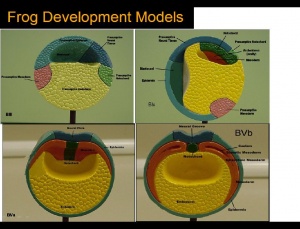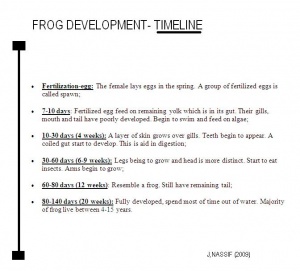2009 Group Project 5: Difference between revisions
mNo edit summary |
|||
| Line 58: | Line 58: | ||
---- | ---- | ||
== Gastrulation == | |||
The phase of Blastulation is followed by the unique developmental progression of gastrulation. Through the rapid growth of the frog gastrulation involves the following processes. | |||
'''1. Epiboly Phase''' | |||
The pigmented cellular materials of blastula have the propensity to overgrow the yolk cells within the developing content. This course which is known as epiboly commences gradually in the final blastula and rapidly accelerates with advancing gastrulation development. The cellular matter within the animal pole reproduces and matures on all sides except in area surrounding the dorsal lip of the blastopore has been established. | |||
'''2. Convergence''' | |||
Scientists suggested that the unfolding was thought to result in spreading of the superficial cells over a substrate with suitable absorption properties. Consequently epiboly and convergence are an outcome to this spreading tendency, which is actually increased by a reduction in surface tension of the distributing cells. | |||
'''3. Rotation''' | |||
The epiboly phase is maintained until the region of the dorsal lip has migrated and is a to some extent greater than 90 degrees and the region of the white blastopore is reduced to small circular rings. This section will be positioned away from the developing vegetal pole. Laterally the complete developing gastrula has been rotated to a horizontal axis, allowing it to lie at right angles to the original median plane of the egg. Therefore, the course of rotation is such that the dorsal lip is practically pushed backwards in one direction as rapid or quicker than epiboly moves it forward in the other. The outcome will be that the blastopore produced at roughly the vegetal pole is posterior, and the dorsal and ventral lips are essentially dorsal and ventral. This in addition allows the eggs to form the antero-ventral side of the potential embryo whilst the area marked by the grey crescent is to develop the dorsal segment. | |||
'''4. Invagination''' | |||
Visible is a small fissure- like invagination which is apparent in the middle between the equator and the vegetal segment. The most superior or dorsal border of the cleft produce the dorsal lip of the blastopore. This imput move back and forth on the dorsal plane near the dorsal lip and migrates around the boundaries of the blastocoel in company with the extension of the lateral lips. This adapted invagination is maintained until the blastocoel cavity has been almost abolished; excluding the slender opening separating epiblasts from the hypoblast, the new segment formed is known as the archenteron cavity. | |||
'''5. Involution''' | |||
Additional to previous course of action a distinct involution also occurs at the blastoporal borders. This is mainly dynamic at the median dorsal lip and gradually more less as it shifts across either side until it reaches the ventral lip where it constant.Throughout this progression, cells positioned beside the superior boundaries of the blastoporal lip migrate over the lip to the interior portion of the lip. These cells are remained within the embryo along the internal edge of the blastopore. This indicates the root of archenteron is composed of involuted cells and beyond this the external layer known as the ectoderm. The base and lateral sides are enclosed mainly of endodermal cellular material, which have been established from larger yolk cells, situated in the vegetal pole of the blastula. In the final phases of the gastrula development, the cells contributing to the floor of the archenteron, thin out significantly where they surround the blastocoel. | |||
The hemispherical shaped dorsal lip of blastopore which become visible at the commencement of the gastruation stage carry on to augment, initially becoming semicircular, then transform into a horse shoe shaped and then finally forming into circular band. The band is the accomplished by the blastopore. Various yolk cells of vegetal pole present in the section are crowed into the blastoporal cavity where they form a gathering identified as a yolk plug. Blastopore rapidly reduces in size while the archenteron is still developing and becomes completely formed in the final stage; the yolk plug appears as only a small oval on the gastrula. | |||
== Differentiation == | |||
== Growth == | |||
[[Image: Mature frog life cyle.jpg|thumb|Image details:Derived from primary source:http://www.scienceclarified.com/images/uesc_01_img0038.jpg]] | [[Image: Mature frog life cyle.jpg|thumb|Image details:Derived from primary source:http://www.scienceclarified.com/images/uesc_01_img0038.jpg]] | ||
Revision as of 17:07, 1 September 2009
The Embryology of Frogs
Growth and development of the Frog
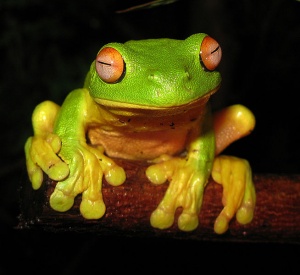
The frog is a well recognised species, abundant predominantly in ponds, swamps, though various species may also exist in damp or shady environments distant from moist habitats. Eggs of specific frogs are easily obtained and may be examined in from the beginning of fertilization onwards. The phases of embryonic development differs in various chordates, yet the typical phases are basically apparent in all frog species. The differences are associated principally to the amount of yolk particles present in an egg. The yolk particles offer nourishment of the developing embryo. The process of frog development will be discussed from the phases of gametogenesis to the adult stage. --Joe Nassif 17:29, 19 August 2009 (EST)
Anatomy of frog
Frogs are classified in animal kingdom as amphibian. This is analysed base on their unique abilities to survive on dryland as well as underwater. In addition, frogs have a pair of lungs that allow them to breathe when on land. When underwater, frog can breathe through their skin. Oxygen in the water can pass through their porous skin and penetrate directly in blood.
Furthermore, frogs have a three-chambered heart with two atria and one ventricle. Unlike humans which possess a four-chambered heart with two atria and two ventricles. A valve with a frog's heart is called spiral valve, which directs the flow of blood to prevent oxgenated and deoxygenated blood from mixing.
Frogs have developed highly specialised anatomical structures in order to adapt different living conditions. Such structures include their powerful hind limbs adapt for both swimming and leaping. The webs on the hind feet provide a large surface area for pushing aganist water. Also, frogs have a highly developed sense of hearing, which aid them to detect high-pictched sounds with their ears and low pictched sounds through their skins. Frogs have a keen sense of sight and smell. They can detect predators and prey using their large eyes that protrude from their head.--Gang Liu 10:26, 27 August 2009 (EST)
The Egg
The embryology of a frog egg is a vast cell; its dimensions are approximately 1.4-1.6 million times larger than a typical aquatic species egg cell. Throughout the frog’s embryonic maturation period, the egg will be transformed into a tadpole encompassing millions of cells but still remains with its constant volume of genetic material. The early embryonic frog structure consists of three main segments the superior hemisphere known as the animal pole which is usually visible as the darkest area. The innermost layer appears to be between the outer two sections known as the gray crescent. Inferiorly, represents the vegetal pole typically lighter than the superior compartment.--Joe Nassif 17:29, 19 August 2009 (EST)
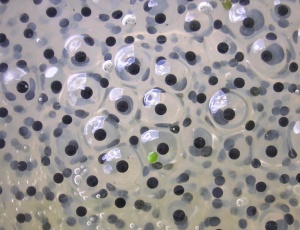
VIDEO RESOURCE: [1]
Gametogenesis
The sexual reproduction occurs through the fusion of either mature reproductive cells or germ cells known as gametes, which include the sperm from the male frog and ova from female frog species so as to form a single cell, the fertilized zygote. The gametes are typically developed in parents of different sexes . Males gametes is a spermatozoon , the female frog gamete is an ovum. Each gamete is formed by a process, recognised as maturation or gametogenesis in gonads. The typical male frog gonads are testies in male, while the female gonads are ovaries. The synthesis of both gonads is associated with the process of fertilization. The zygote changes into a mature frog through the process of embryology and metamorphosis. Gametogenesis is a progression which frog gametes are established from cells, called germ cells. Initial germ cells are called primordial germ cells, which can be recognised extremely early in the life of frog species.--Joe Nassif 13:30, 27 August 2009 (EST)
Project Content:JOE NASSIF z3295026 (first 6 topics)
1.The Egg
2.Fertilization
3.
Cleavage
The egg of the frog is scientifically identified as’ telolecithal’ meaning there is a outsized amount of yolk concentrated at a single pole, in contrast to the concentration of cytoplasm and the site of the nucleus. The cleavage phases are holoblastic, therefore the total and after the second cleavage they are asymmetrical .The initial cleavage stage appears about two and half to three hours after fertilization. It commences as a minor depression in close proximity to the centre of the animal hemisphere. It appears as if some interior force is pushing the surface the egg towards the centre. This small upturned fold steadily continues in the form of a channel until it surrounds the egg. This groove is shallow in the commencement, but develop into deeper eventually separating the fertilized egg into two halves recognised as the blastomeres. Internally the separation is mitotic, consequently each daughter cell contains a nucleus resulting from the copulation nucleus of the fertilised egg. This cleavage is vertical, the two cells are indistinguishable in respect of cytoplasm, pigment and yolk. The subsequent cleavage appears about an hour after the first. The channel of this cleavage begins at the centre of the animal hemisphere, is at right angles to the first and is vertical. This divides the egg into four blastomeres. The fourth blastomere so produced are not qualitatively equal, since of these only two contain the material from the gray crescent. The cleavage begins about thirty minutes after the second is completed or four hours after fertilisation. the cleavage plane of the third furrow is horizontal and slightly above the equator. Thus the four upper cells are a little smaller than the four lower cells. The smaller blastomeres are called micromeres and the larger blastomeres are called macromeres. The fourth cleavages follow 20 minutes after the third and tend to be vertical. This is usually a double furrow. The cleavage rate is accelerated with each of the early divisions and since the blastomeres are of unequal size and have varying amounts of cytoplasm and yolk, synchronous cleavage is lost and there is an obvious overlapping of the division. The upper most cells divide more rapidly than the lowermost cells. From this point onwards perfect symmetry in cleavage and in blastomere is very rare, although the embryo developed perfectly. The fifth cleavage is also doubled, appearing first in the upper hemisphere and then in the lower. The cleavage thus far follows the rule that each cleavage plane comes in at right angles to the previous one. The subsequent divisions become so irregular that it is previous one. The subsequent division become so irregular that it is impossible to trace out any plan or procedure. The segmentation continues more rapidly in the pigmented regions, since at that place the protoplasm is most dense, whereas, yolk which is very abundant in the vegetal side delays cell division. The multicelluar embryo at this stage is called morula by some biologists.--Joe Nassif 13:31, 27 August 2009 (EST)
Gastrulation
The phase of Blastulation is followed by the unique developmental progression of gastrulation. Through the rapid growth of the frog gastrulation involves the following processes.
1. Epiboly Phase The pigmented cellular materials of blastula have the propensity to overgrow the yolk cells within the developing content. This course which is known as epiboly commences gradually in the final blastula and rapidly accelerates with advancing gastrulation development. The cellular matter within the animal pole reproduces and matures on all sides except in area surrounding the dorsal lip of the blastopore has been established.
2. Convergence
Scientists suggested that the unfolding was thought to result in spreading of the superficial cells over a substrate with suitable absorption properties. Consequently epiboly and convergence are an outcome to this spreading tendency, which is actually increased by a reduction in surface tension of the distributing cells.
3. Rotation
The epiboly phase is maintained until the region of the dorsal lip has migrated and is a to some extent greater than 90 degrees and the region of the white blastopore is reduced to small circular rings. This section will be positioned away from the developing vegetal pole. Laterally the complete developing gastrula has been rotated to a horizontal axis, allowing it to lie at right angles to the original median plane of the egg. Therefore, the course of rotation is such that the dorsal lip is practically pushed backwards in one direction as rapid or quicker than epiboly moves it forward in the other. The outcome will be that the blastopore produced at roughly the vegetal pole is posterior, and the dorsal and ventral lips are essentially dorsal and ventral. This in addition allows the eggs to form the antero-ventral side of the potential embryo whilst the area marked by the grey crescent is to develop the dorsal segment.
4. Invagination
Visible is a small fissure- like invagination which is apparent in the middle between the equator and the vegetal segment. The most superior or dorsal border of the cleft produce the dorsal lip of the blastopore. This imput move back and forth on the dorsal plane near the dorsal lip and migrates around the boundaries of the blastocoel in company with the extension of the lateral lips. This adapted invagination is maintained until the blastocoel cavity has been almost abolished; excluding the slender opening separating epiblasts from the hypoblast, the new segment formed is known as the archenteron cavity.
5. Involution
Additional to previous course of action a distinct involution also occurs at the blastoporal borders. This is mainly dynamic at the median dorsal lip and gradually more less as it shifts across either side until it reaches the ventral lip where it constant.Throughout this progression, cells positioned beside the superior boundaries of the blastoporal lip migrate over the lip to the interior portion of the lip. These cells are remained within the embryo along the internal edge of the blastopore. This indicates the root of archenteron is composed of involuted cells and beyond this the external layer known as the ectoderm. The base and lateral sides are enclosed mainly of endodermal cellular material, which have been established from larger yolk cells, situated in the vegetal pole of the blastula. In the final phases of the gastrula development, the cells contributing to the floor of the archenteron, thin out significantly where they surround the blastocoel. The hemispherical shaped dorsal lip of blastopore which become visible at the commencement of the gastruation stage carry on to augment, initially becoming semicircular, then transform into a horse shoe shaped and then finally forming into circular band. The band is the accomplished by the blastopore. Various yolk cells of vegetal pole present in the section are crowed into the blastoporal cavity where they form a gathering identified as a yolk plug. Blastopore rapidly reduces in size while the archenteron is still developing and becomes completely formed in the final stage; the yolk plug appears as only a small oval on the gastrula.
Differentiation
Growth
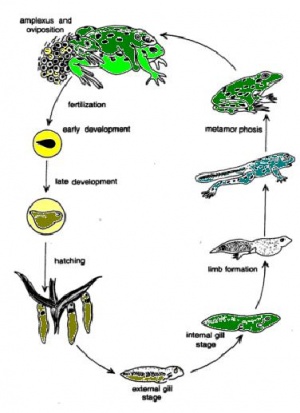
Gastrulation
The start of gastrulation is marked by the pushing inward of the cells in the region of embryo. This produces, first, an opening that will be the future anus. Second, a cluster of cells that develops into the Spemann organiser. As gastrulation continus, three different germ layers are formed. These are ectoderm, mesoderm and endoderm. --Gang Liu 18:27, 19 August 2009 (EST)
Germ-layer origin of various body tissues
Ectoderm will give raise to structures such as skin, brain, spinal cord, neurons and sense receptors. Mesoderm will give raise to structrues such as notochord, muscles, blood, bone and sex organs. Endoderm will give raise to sturctures such as inner lining of gut, liver, pancreas, lungs and bladder, thyroid and parathyroid glands and thymus.--Gang Liu 18:32, 19 August 2009 (EST)
Timeline of development
- Fertilization-egg: The female lays eggs in the spring. A group of fertilized eggs is called spawn;
- 7-10 days: Fertilized egg feed on remaining yolk which is in its gut. Their gills, mouth and tail have poorly developed. Begin to swim and feed on algae;
- 10-30 days(4 weeks): A layer of skin grows over gills. Teeth begin to appear. A coiled gut start to develop. This is aid in digestion;
- 30-60 days(6-9 weeks): Legs being to grow and head is more distinct. Start to eat insects. Arms begin to grow;
- 60-80 days(12 weeks): Resemble a frog. Still have remaining tail;
- 80-140 days(20 weeks): Fully developed, spend most of time out of water. Majority of frog live between 4-15 years.--Gang Liu 11:19, 27 August 2009 (EST)
Stages of frog embryology
1Abnormalities of frog
Abnormalities of frog could be caused by multiple factors. These include change in climate, predators, parasites, bacteria, fungi, viruses or pollution and contaminants such as pesticides, metals and fertiliser.--Gang Liu 10:40, 27 August 2009 (EST)
7.Timeline -how long
8. Diagram (Hand-drawn)
9. Germ-layer origin of various body tissues
10.Developmental factors associated with specfic stages of growth
11. Staging - are there species specific staging, what occurs when
12.History of Model Use - when was it first used, what embryology research
13.Genetics - chromosome number, sequencing
Current Embrology Research
Currently, a number of fields have benefited from the development of frog embrology. These include cloning, verification of messenger RNA, and Cell cycle.
Cloning
In 1952, Robert Briggs and Thomas J King cloned northern leopard frogs using a method of nuclear transfer. Briggs and King's experiment was similar to that envisioned - and piloted using salamanders - by Hans Spemann in his 1938 proposal for a 'fantastical experiment'. Later, John Gurdon extended this work and showed that nuclei from differentiated cells could support development, although less well than those from early embryos.
Verification of messenger RNA
While the existence and role of messenger RNA (mRNA) was known in bacteria, in the 1960s it was still debated whether it also existed in vertebrates. Taking haemoglobin mRNA from immature red blood cells and injecting it into a Xenopus oocyte, John Gurdon showed that the haemoglobin protein was indeed produced. Producing proteins in Xenopus oocytes has proved to be extremely useful in cell biology, in particular for the study of receptor proteins.
Cell Cycle
As they develop outside the mother, frog eggs are well stocked with the proteins needed to drive the development of the embryo. Studies of these processes has shed considerable light on the processes involved in cell division - termed the cell cycle.--Gang Liu 18:51, 19 August 2009 (EST)
14. Current Embryology Research - research papers and findings
Glossary
References - Frog Embryology:
--Mark Hill 16:24, 29 August 2009 (EST) I have fixed these references.
2. xenbase
4. bioethics frog Just a little cycle of FROG'S life cycle
ANAT2341 group projects
Project 1 - Rabbit | Project 2 - Fly | Project 3 - Zebrafish | Group Project 4 - Mouse | Project 5 - Frog | Students Page | Animal Development
| Stage characteristics | Cell characteristics | location |
|---|

